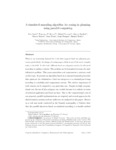A simulated annealing algorithm for zoning in planning using parallel computing

Use este enlace para citar
http://hdl.handle.net/2183/20940
A non ser que se indique outra cousa, a licenza do ítem descríbese como Atribución-NoComercial-SinDerivadas 3.0 España
Coleccións
- Investigación (FIC) [1705]
Metadatos
Mostrar o rexistro completo do ítemTítulo
A simulated annealing algorithm for zoning in planning using parallel computingAutor(es)
Data
2016Cita bibliográfica
Santé, I., Rivera, F. F., Crecente, R., Boullón, M., Suárez, M., Porta, J., ... & Doallo, R. (2016). A simulated annealing algorithm for zoning in planning using parallel computing. Computers, Environment and Urban Systems, 59, 95-106.
Resumo
[Abstract] There is an increasing demand for tools that support land use planning processes, particularly the design of zoning maps, which is one of the most complex tasks in the field. In this task, different land use categories need to be allocated according to multiple criteria. The problem can be formalized in terms of a multiobjective problem. This paper generalizes and complements a previous work on this topic. It presents an algorithm based on a simulated annealing heuristic that optimizes the delimitation of land use categories on a cadastral parcel map according to suitability and compactness criteria. The relative importance of both criteria can be adapted to any particular case. Despite its high computational cost, the use of plot polygons was decided because it is realistic in terms of technical application and land use laws. Due to the computational costs of our proposal, parallel implementations are required, and several approaches for shared memory systems such as multicores are analysed in this paper. Results on a real case study conducted in the Spanish municipality of Guitiriz show that the parallel algorithm based on simulated annealing is a feasible method to design alternative zoning maps. Comparisons with results from experts are reported, and they show a high similarity. Results from our strategy outperform those by experts in terms of suitability and compactness. The parallel version of the code produces good results in terms of speed-up, which is crucial for taking advantage of the architecture of current multicore processors.
Palabras chave
Land use optimization
Land use planning
Parallel algorithms for multicores
Decision support
Simulated annealing
Land use planning
Parallel algorithms for multicores
Decision support
Simulated annealing
Versión do editor
Dereitos
Atribución-NoComercial-SinDerivadas 3.0 España
ISSN
0198-9715
1873-7587
1873-7587






